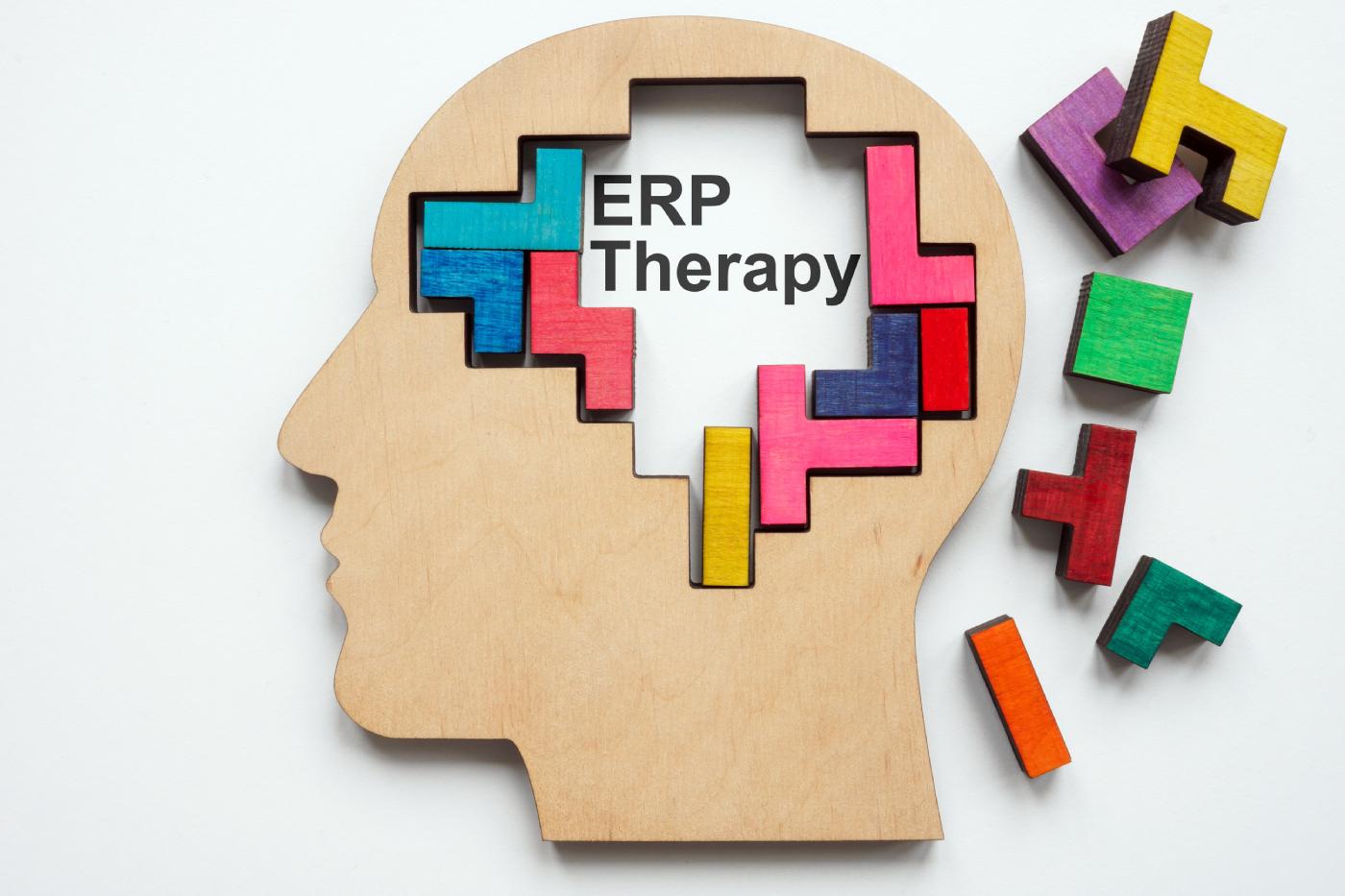What is ERP Therapy and How Can It Help OCD Symptoms?

Understanding ERP Therapy: A Lifeline for OCD
What is Exposure and Response Prevention Therapy? Exposure and Response Prevention (ERP) is a type of cognitive behavioral therapy that helps you confront your fears and resist the urge to fix or balance out your obsessive thoughts by doing compulsive behaviors. Instead, you learn to let those OCD thoughts happen without reacting to them. In other words, it helps you tolerate distress to things that trigger your fears. Over time, you even realize that the feared situation is not as dangerous as you once believed, and you no longer feel the need to act on obsessive thoughts. Big win for your mental health and overall wellbeing

- A comprehensive review and meta-analysis of 24 studies revealed that ERP is significantly more effective than other treatments in reducing OCD symptoms. The study looked at 24 different research papers with over 1,100 people and saw that response prevention made a bigger difference in reducing OCD symptoms compared to other methods. Adding some cognitive exercises to ERP made it even more effective. However, the amount of therapy or how long someone had OCD didn’t change how well ERP worked. This means exposure and response prevention is a great choice for treating OCD.
How ERP Therapy Targets OCD Symptoms at Their Core
How does ERP therapy work for OCD? Obsessive-Compulsive Disorder (OCD) involves persistent, distressing thoughts and repetitive actions meant to ease those fears. Although managing OCD can feel overwhelming, response prevention can break the cycle.
According to the International OCD Foundation, ERP consists of two main parts:
- Exposure: The individual is gradually exposed to the OCD thoughts, situations, or objects that trigger their obsession. For example, someone who fears germs might be gently guided to touch fresh dirt.
- Response Prevention: After the trigger, the person is encouraged to avoid their usual compulsive response. For example, instead of repeatedly sanitizing their hands after touching the dirt, they might be asked to wash just once.
The Neurological Impact of ERP Therapy on the Brain
ERP therapy isn’t just about confronting your fears—it’s a powerful way to reshape how your brain processes anxiety. If you’re curious about how it actually changes your brain, let’s dive into the science behind this exposure therapy:
- A 2017 study examining brain connectivity changes before and after cognitive behavioral therapy for OCD found that it significantly improves connectivity within several brain networks. For example, increased connectivity was observed between the cerebellum and other regions, such as the caudate, putamen, and prefrontal cortices. These changes in brain networks are linked to greater resistance to compulsions and suggest that CBT may help by fostering new goal-directed behaviors and thought patterns.
- A 2022 meta-analysis looked at how well response prevention therapy works for people with OCD and Tourette Syndrome (TS). The findings showed that ERP helps reduce symptoms for both conditions and works similarly for different age groups and therapy types. While more research is needed to pinpoint the exact neurological mechanisms, it’s believed that its benefits may be linked to changes in the prefrontal cortex and anterior cingulate cortex. The prefrontal cortex plays a crucial role in decision-making, self-control, and regulating emotions, which are central to managing OCD and TS symptoms. Understanding how response prevention impacts these brain areas can help refine and enhance treatment strategies.
What to Expect in ERP Therapy Sessions

What is an example of an ERP treatment plan? In response prevention therapy sessions, you can expect a structured, gradual approach to facing your fears and reducing compulsive behaviors. Here’s a breakdown of what to anticipate:
1. Assessment and Goal Setting
At the start, your therapist will work with you to understand your OCD triggers, fears, compulsions, and avoidance behaviors. Together, you’ll set clear goals for the therapy, such as reducing the frequency of compulsive behaviors, tolerating distress or easing anxiety in specific situations. For example, perhaps you check the stove multiple times before leaving the house to ensure it’s turned off. Your ERP goal, therefore, might be to leave the house after checking the stove only once, resisting the urge to return and repeatedly check.
2. Hierarchy of Fears
You’ll also create what’s known as an “exposure hierarchy,” a personalized list that ranks your fears from least to most distressing. This hierarchy serves as a roadmap for therapy, starting with manageable challenges and working toward the more difficult ones. For instance, a less distressing step might be touching a clean surface without immediately washing your hands, while a more distressing one could involve shaking hands with someone and waiting 15 minutes before washing. This step-by-step approach helps you build resilience and confidence as you face each fear.
3. Exposure Exercises
In each session, you’ll confront one of the fears from your list in a controlled and supportive environment. These exposure exercises are designed to help you face your anxieties without falling back on compulsive behaviors. For example, you might start by looking at pictures, watching videos, or even stepping outside the office to engage with your fear directly, all under the guidance of your therapist. In each step, you’ll acquire clear strategies to resist your compulsions. You might also receive guidance to imagine the feared outcome, helping you process it in real-time.
- A 2022 meta-analysis of 30 studies found that ERP therapy is effective in treating OCD compared to placebo and drug treatments. Specifically, exposure and response prevention significantly improves OCD symptoms and reduces depression and anxiety, and longer therapy sessions enhance its effectiveness. Additionally, combining therapist-guided exposure with self-controlled exposure offers enhanced results.
4. Reflection and Progress
After each exposure, you’ll have a debrief with your therapist, discussing how the experience unfolded, what emotions surfaced, and how you managed your compulsions. This step will help you identify patterns, reinforce your progress, and understand the impact of facing your fears head-on. Over time, these repeated exposures begin to rewire your brain. By confronting your anxieties without resorting to compulsions, you’re teaching your brain that these feared situations are not as dangerous as they seem. As a result, the fear response weakens, and the compulsions lose their grip.
5. Homework
Exposure and response prevention is most effective when practiced outside of therapy, so your therapist will likely assign homework. This might include repeating exposures at home or in real-life settings to help reinforce the progress you’re making. Each step forward helps you build new neural pathways, reduce the hold of old habits and foster a more balanced response to your fears.
6. Gradual Improvement
What is the success rate of ERP therapy for OCD? ERP is considered the gold-standard treatment for treating OCD, and its success rate is approximately 65% to 80%. By following your plan and speaking with your therapist, you’ll notice that the fear and anxiety linked to your obsessions diminish. The compulsions you used to rely on will become less necessary, and you’ll feel more confident facing your triggers without needing to perform rituals.
Getting Started with ERP Therapy
What exactly is ERP therapy? It’s a proven, life-changing approach designed to reduce OCD symptoms, give you control over your compulsions, and help you feel more confident and at peace.
Ready to take the next step toward a more empowered and fulfilling life? Our personalized treatment plans, rooted in cognitive therapy, will boost your resilience, help you manage distress, and make life feel exciting again—rather than mentally draining. Schedule a FREE consultation, either in person or from the comfort of your home. Or, connect with our intake coordinator for a FREE call to find the perfect therapist tailored to your needs.

